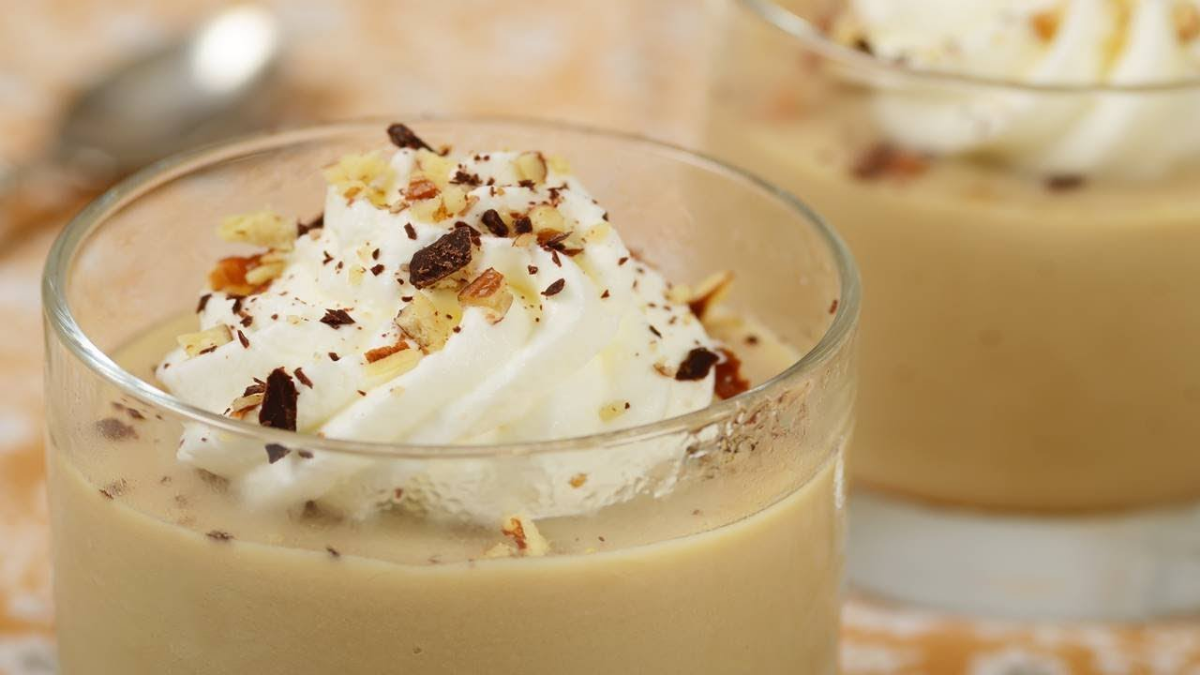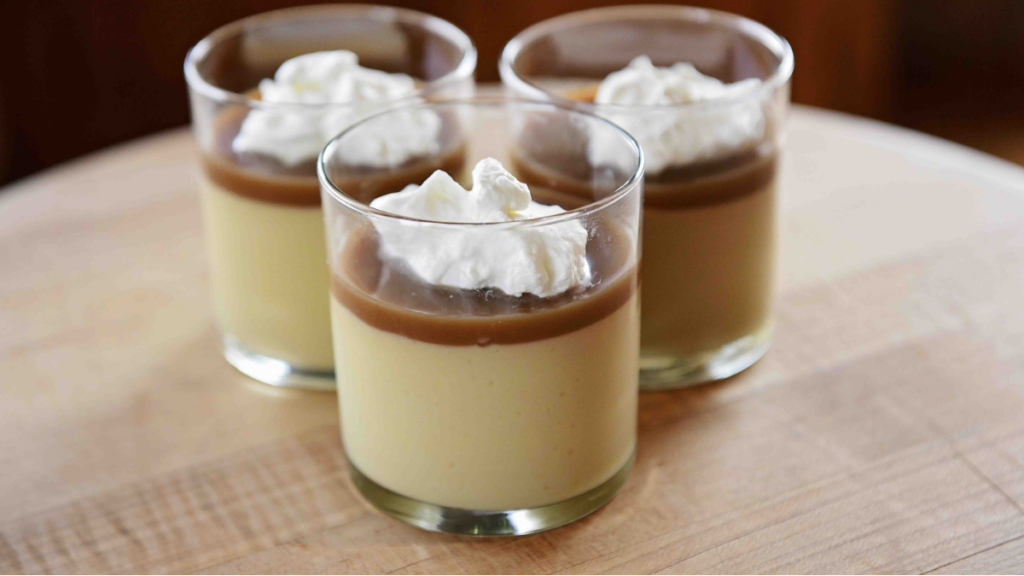This quick and easy Butterscotch Pudding is ready in minutes! This quick pudding recipe is silky smooth, rich, and creamy, and you’ll never go back to boxed pudding mix again! If you like butterscotch, you must try these Butterscotch Shortbread Cookies and Butterscotch Almond Toffee! Pudding cooked from scratch is superior to store-bought alternatives and is simple to prepare. This butterscotch pudding recipe employs pantry goods and a straightforward method that even a beginner cook can master.
How to Make Butterscotch Pudding?
Many individuals are confused about the difference between caramel and butterscotch. The most significant difference is that caramel uses granulated sugar while butterscotch uses brown sugar. This pudding tastes so lovely because of the added flavour from the brown sugar. This recipe can be made with either dark or light brown sugar, and dark brown sugar has a more complex flavour.
This pudding recipe is straightforward because the ingredients are mixed in the saucepan BEFORE the heat is turned on. The mixture only needs to be brought to a simmer and held for 2 minutes once all ingredients are incorporated and smooth. Then remove from the heat and whisk in the butter and vanilla extract.
In a 2- or 3-quart saucepan, whisk together the following ingredients: yolks of eggs, salt, brown sugar, cornstarch a quarter cup of half-and-half (or milk if that is what you are using). Whisk in the remaining half and half gradually (or milk). Bring to a low simmer over medium heat, whisking continuously.
Once the mixture has reached a simmer, whisking constantly for 2 minutes, maintaining the same temperature. Do not allow the water to boil. Remove the skillet from the heat and add the butter and vanilla extract, whisking constant strain in the pudding mixture into a large measuring using a fine-mesh strainer cup. This step is optional, but it assures that your pudding is free of lumps. Cover with plastic wrap and divide the pudding evenly among ramekins or small bowls. (Recommendations are shown below.)
Refrigerate for 4 hours or overnight until the pudding is firm and cooled. Chill before serving.
Ingredients
- Six yolks of eggs
- 1 1/2 cups dark or light brown sugar, tightly packed
- cornstarch, 3 tbsp
- 1/2 teaspoon salt
- 3 cups whole milk OR half and half
- Four tablespoons of unsalted butter
- One teaspoon of vanilla essence
Instructions
- Place six tiny ramekins or bowls on the table. (I prefer to put them on a quarter sheet pan to make moving them to the fridge more straightforward.)
- In a 2 or 3 quart saucepan, whisk together egg yolks, brown sugar, cornstarch, salt, and about 1/4 cup half and a half (or milk). Whisk the mixture until it is smooth and lump-free.
- Whisk in the remaining half and half gradually (or milk).
- Bring to a low simmer over medium heat, whisking continuously.
- Once the mixture has reached a simmer, whisk continuously for 2 minutes, ensuring it does not boil.
- Remove the pan from the heat and add the unsalted butter cubes and vanilla extract.
- Strain the pudding mixture into a large measuring cup using a fine-mesh strainer. Cover the ramekins with plastic wrap and divide the pudding evenly among them.
- Refrigerate for 4 hours or overnight until the pudding is firm and cooled.
- Remove the plastic wrap and serve cold.
Why does my Butterscotch Pudding have a Gritty Texture?
If you incorporate the sugar and eggs too soon while waiting for the milk mixture to simmer but do not whisk frequently enough, the sugar can thicken the eggs, resulting in a gritty final texture. Whisk the egg yolks into the sugar when the milk/cream combination comes to a simmer (don’t do this too soon before the milk is ready – the sugar will draw moisture from the egg yolks, resulting in a grainy, unpleasant texture). Any parts that hadn’t been adequately broken down became gritty on the tongue when the pudding cooled, and the fat solidified.
When you vigorously whisk the pudding or any custard with a lot of butter, the fat breaks down into tiny droplets that are impossible to discern until the liquid cools. Use an immersion blender to make a lump-free custard. Even when cold, a brief pulse with it will efficiently break them down, restoring the desired creamy texture.
What’s the Difference Between Pudding and Dessert?
To put it simply, the most apparent distinction between a pudding and a dessert is that a dessert is sweet, whereas a pudding can be both sweet and savory, and it is typically used to define a specific type of food or sweet. Fruits sliced with a fork and knife could be served as a dessert, and for pudding, you use a spoon. The most evident distinction between a pudding and a dessert in the United Kingdom and Ireland is that a dessert must be sweet, but a pudding can be sweet or savory. To put it simply, the most apparent distinction between a pudding and a dessert is that a dessert is sweet.
Whereas a pudding can be both sweet and savory, it is typically used to define a specific type of food or sweet. Fruits sliced with a fork and knife could be served as a dessert. The reason for adopting the name “pudding” rather than “dessert” is due to the British class system. Pudding is described as simple, rustic delicacies like spotted dick and rice pudding, widespread among the lower classes. Allow the pudding to cool uncovered before covering with plastic wrap and refrigerating if you prefer a skin (film) on top.
What are Cake Puddings?
Is that pudding (initially) a blood sausage, but cake is a decadent, sweet treat made chiefly of flour, sugar, and eggs, baked in an oven, and frequently coated in icing. The pudding is smooth, looks like this, and is usually chocolate or vanilla in flavour. The cake is anything that resembles this and has a gritty feel from the non-yeast dough. Brownies, for example, do not qualify as cake because they are too dense. Christmas cake is a rich cake with dried fruits frequently covered in icing and marzipan, while Christmas pudding is a rich steamed pudding prepared with flour, suet, and dried fruits.
English dessert puddings are more uniform, involving eggs, starch, and dairy, similar to a dense cake. Tray pudding, made from steamed sponge cake, and Christmas pudding, made from dried fruit bound together by egg and suet, are two sweet English puddings. Pudding is a term used to describe a variety of meals that have a soft, spongy, and thick texture. Puddings are almost always delicious sweets made with milk or fruit juice and thickened with cornstarch, arrowroot, flour, tapioca, rice, bread, or eggs in the United States.
Is it Possible to Put the Pudding on a Cake?
May you put the pudding on a You can build a moist and homemade cake with a cake mix and an additional ingredient: pudding. Adding an instant pudding mix to your cake mix and adjusting the other ingredient amounts and bake time will result in a fantastic cake that no one will guess came from a box. Fill the middle of each cake layer with pudding. On top of the first cake layer, place the second cake layer. With the second cake layer, repeat the icing and pudding steps.
If the cake contains perishable ingredients like fresh fruit, whipped cream, meringue style topping, eggs, or custard, it may need to be refrigerated before icing or filling. Adding pudding to the cake mix doesn’t significantly alter the flavour, but it does make the cake moister and homemade-tasting. In addition, the quick pudding can make cakes last longer. A pudding mix is ideal for quick bread, sheet cakes, and bundt cakes because of these ingredients.
Conclusion
Butterscotch Pudding is made with simple ingredients that you probably already have on hand. You’re making a “cooked” custard when you make this pudding. The only significant distinction between a pudding and a custard is the presence of cornstarch (corn flour). A baked pudding is thickened with cornstarch so that it may be eaten with a spoon. The crucial thing to remember is that puddings must be adequately prepared to avoid lumps or, even worse, burning. As a result, keep the heat low and use a heavy-bottomed pot, stirring regularly with a big heatproof rubber spatula.
It is critical to reaching the saucepan’s bottom, sides, and corners during stirring. Eliminate the pudding from the heat once it has thickened to the consistency of mayonnaise, and sieve it to remove any lumps that have developed. The butter and vanilla extract are then added. If you prefer your pudding warm, go ahead and eat it now. If you want your pudding cold, wrap it in plastic wrap and place it in the refrigerator until stiff (a couple of hours).

